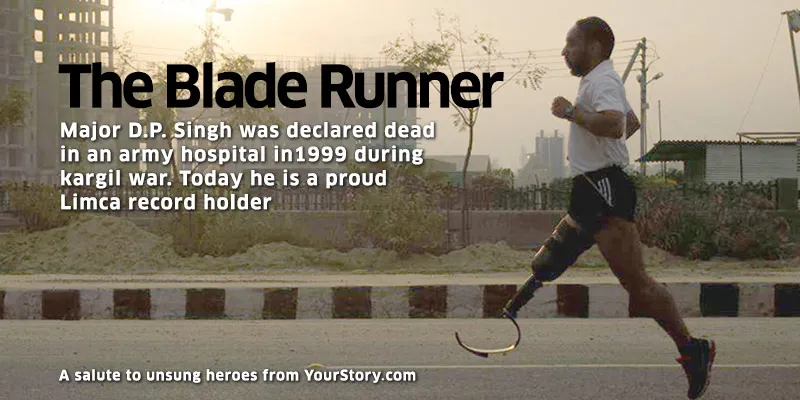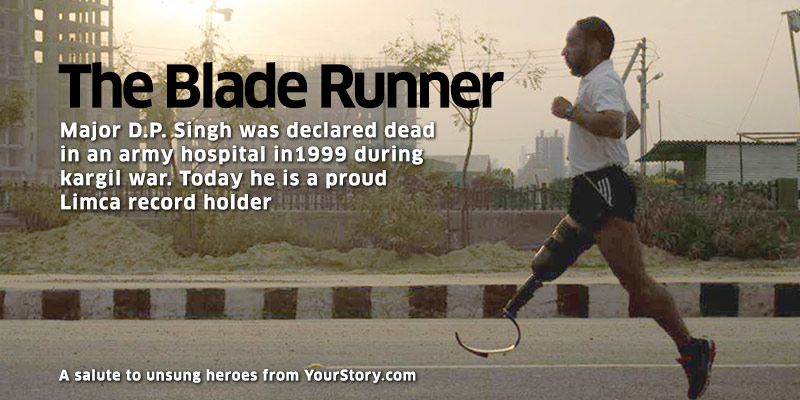He was blown apart by a mortar and left for dead on a Kargil battlefield. Now, he's running marathons
A mass of bleeding tissue, broken bones and intestines ripped out. That was Major Devender Pal Singh when fellow soldiers carried him to the field hospital. A mortar bomb had landed close to him on a Himalayan battlefield, during the 1999 Kargil War on the India-Pakistan border. The army surgeon declared him dead on arrival and sent his wrecked body to a makeshift mortuary. But 25-year-old Major Singh was not ready to die.
The story of how he beat death sounds incredible when you see him today, full of vitality. Now known as the 'Indian Blade Runner', he has been running marathons for 16 years.

It was at the mortuary on the mountains that another doctor from the army hospital spotted life in him. The chances of survival for anybody caught within eight yards of a mortar bomb are close to nil. He was embedded with sharapnel all over and his stomach was split wide open. The doctors had no choice but to remove some of his intestines. His leg had to be amputated too. But Major Singh refused to die.
Wafer thin, bedridden and disabled, the Major drew upon the survival instincts and courage that had spurred him to dive to the ground when the bomb landed about a yard and a half from him. Quick thinking had saved his life, but he would now have to learn to live anew.
"This was the start of my second life," he told YourStory on the sidelines of the India Inclusion Summit in Bangalore. So what if life would never be the same again? It never is anyway. He decided not to think of his battered body as a disability. He looked upon it as a challenge, instead.
He stayed in hospital for almost a year. Hardly anyone believed he would ever walk again. But he thought, "Why just walk? I want to run."
Major DP Singh's transformation into the Indian Blade Runner didn't happen overnight. He was never a runner before the amputation. But, "I wanted to run to inspire myself to go beyond my injuries," to told YourStory.
Running with his prosthetic leg wasn't just hard, it was excruciatingly painful. "I refused to crawl. Every time I fell, I took it as a test of perseverance. That way, it is easier to try again," he recollected.
His first prosthetic limb was better suited for sprints than long distance running. Nevertheless, however agonising it was, the Major was already running marathons when prosthetics specialists at Hanger Clinic in Oklahoma City chanced upon a video clip of him. They invited him over to fit him with a better prosthetic that allowed him the greater flexibility needed for long distance running.
Today, at 39, the Indian Blade Runner has run close to 20 marathons. When he runs, he doesn't hide his artificial leg. Onlookers often drop their jaws and stare. That doesn't bother him.
He is also a motivational speaker, inspiring amputees across India. He manages a support group called The Challenging Ones.
"I started this support group to inspire others in a similar predicament. Sports can help build confidence and help overcome the disability," he said. "People like me are generally called physically challenged. But I believe we are 'challengers'. The trauma of losing a part of your body is huge. Your family and friends cannot imagine life after amputation. The initial stage where the person realises that s/he has lost a limb is the most difficult. Peer support is crucial."
His aim is to help amputees find life again. "Make the Challengers break all shackles of dependency and overcome fears of lack of mobility to live as they did earlier. There is no limit," he says.
This Republic Day, YourStory salutes his indomitable spirit. Check-out his interview with YourStory below.











